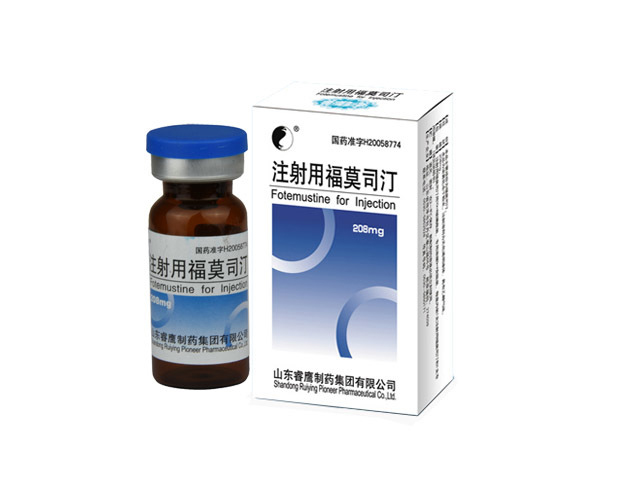Fotemustine for Injection

Fotemustine for Injection
English name: FotemustineforInjection
Chinese Pinyin: ZhusheyongFumositing
The main ingredient of this product is famoxetine.
Chemical name: (±) 1- [3- (2-chloroethyl) -3-nitroso urea] ethyl phosphite diethyl ester.
Molecular formula: C9H19ClN3O5P
Molecular weight: 315.69
Description: This product is a light yellow freeze-dried powder. Injection solvent is colorless and transparent
[Drug Name]
Common name: Injection of Fomostine
English name: Fotemustine for Injection
Chinese Pinyin: Zhusheyong Fumositing
Ingredients
The main ingredient of this product is famoxetine.
Chemical name: (±) 1- [3- (2-chloroethyl) -3-nitroso urea] ethyl phosphite diethyl ester.
Molecular formula: C9H19ClN3O5P
Molecular weight: 315.69
【 Description 】 This product is a light yellow freeze-dried powder. The injection solvent is a colorless transparent liquid with an ethanol odor.
[Indications] Used for the treatment of primary malignant brain tumors and disseminated malignant melanoma (including brain regions).
[Specification] 208mg
[Usage and Dosage]
Prepare the solution immediately before use. Once the solution is prepared, it must be administered under dark conditions; Intravenous infusion should be controlled for at least 1 hour.
Dissolve the contents of the famoxetine bottle with 4ml sterile ethanol solution in an ampoule, calculate the dosage, dilute the solution with 250ml 5% isotonic glucose injection, and use it for intravenous infusion.
1. Single agent chemotherapy includes:
Induction therapy: After three consecutive sessions once a week, discontinue medication for 4-5 weeks.
Maintenance therapy: Treatment every three weeks.
Usually, a dose of 100mg/m2 is used.
2. Combination chemotherapy: Remove the third dose in induction therapy and maintain a dose of 100mg/m2.
Adverse reactions
1. Adverse reactions mainly have an impact on hematology, manifested as thrombocytopenia (40.3%) and leukopenia (46.3%), occurring relatively late, with the lowest levels occurring at 4-5 weeks and 5-6 weeks after the first dose of induction therapy, respectively.
If chemotherapy and/or the combination of this product with other drugs that can induce hematopoietic toxicity have been performed before the injection of famoxetine treatment, it will increase adverse reactions in the blood system.
2. Common moderate nausea and vomiting (46.7%), mostly occurring within 2 hours after injection. In addition, there is a moderate, temporary, and reversible increase in aminotransferase, alkaline phosphatase, and blood bilirubin (29.5%).
3. Rare adverse reactions include fever (3.3%), injection site phlebitis (2.9%), diarrhea (2.6%), abdominal pain (1.3%), temporary increase in urea (0.8%), itching (0.7%), temporary and reversible neurological dysfunction (consciousness disorders, sensory abnormalities, loss of taste) (0.7%), etc.
When used in combination with dacarbazine (see drug interactions), minimal pulmonary toxicity (acute adult respiratory depression syndrome) was observed.
Taboos
1. Pregnant and lactating women;
2. Prohibited for the combined use of yellow fever vaccines and the use of phenytoin as preventive treatment (see drug interactions);
3. It is generally not recommended to use this product in combination with attenuated live vaccines.
【 Precautions 】
1. It is not recommended to use this product for patients who have received chemotherapy within the past 4 weeks (or have been treated with nitrosamines within 6 weeks).
2. Patients should only consider using this product if their platelet and/or granulocyte counts are equal to or greater than 100000/mm3 and 2000/mm3, respectively.
3. Before each new administration, blood cell counts must be performed and the dosage of medication adjusted according to the hematological status. The following table can serve as a guide:
4. It is recommended to have an interval of 8 weeks from the start of induction therapy to the start of maintenance therapy. The interval between every two maintenance therapy cycles is 3 weeks.
Maintenance therapy is only considered when platelet and/or granulocyte counts reach 100000/mm3 and 2000/mm3, respectively.
6. It is recommended to conduct liver function tests during induction and subsequent treatment.
7. The prepared solution should avoid contact with the skin and mucous membranes, as well as the possibility of absorption of any drug solution. It is recommended to wear a mask and protective gloves when preparing the solution. If accidentally spilled, rinse thoroughly with water.
8. Polluted items should be discarded under safe conditions.
【 Pregnant and lactating women's medication 】 This product is prohibited during pregnancy and lactation.
There is currently no research on this product in children.
[Elderly medication] This experiment was not conducted and there are no reliable references available.
Drug interactions
Has the same interaction as all cytotoxic drugs.
1. Because tumors increase the risk of blood clots, anticoagulant therapy is usually used. There are significant individual differences in blood coagulation in tumor cases, which increases the unpredictable interaction between oral anticoagulants and anti-tumor chemotherapy. Therefore, if it is decided to treat patients with oral anticoagulants, it is necessary to increase the frequency of INR tests.
2. Taboos for combination therapy
1) Phenytoin (used to prevent seizures induced by certain anti-tumor drugs)
When using doxorubicin, daunorubicin, carboplatin, cisplatin, carmostine, vincristine, vinblastine, bleomycin, and methotrexate, the absorption of phenytoin in the digestive tract is reduced due to cell proliferation inhibitors, leading to seizures. Can be used in combination with anticonvulsant benzodiazepines for a short period of time.
2) The yellow fever vaccine poses a risk of widespread and fatal vaccine diseases.
3. Combination medication needs to be considered
1) Cyclosporin (doxorubicin, etoposide): may have excessive immune suppression, leading to the risk of lymphoid tissue proliferation.
2) Immunosuppressants (derived from cyclosporin extrapolation): Excessive immunosuppression increases the risk of lymphocyte proliferation.
4. Specific interactions between this product and dacarbazine:
When this product is used together with high-dose dacarbazine on the same day, occasional pulmonary toxicity (acute adult respiratory distress syndrome) may occur. Be careful to avoid this administration method.
Combination therapy should be performed according to the following recommended methods:
1) Induction therapy:
Fumostine 100mg/m2/day on day 1 and day 8.
Dacarbazine 250mg/m2/day, on days 15, 16, 17, and 18.
A 5-week treatment rest period.
2) Maintenance therapy:
Fumostine 100mg/m2/day, on the first day.
Dacarbazine 250mg/m2/day, on days 2, 3, 4, and 5.
There is currently no specific antidote for drug overdose, and blood monitoring needs to be strengthened.
Pharmacology and Toxicology
Fumostine is an anti-tumor drug in the nitroso urea class that inhibits cell proliferation. It has alkylation and carbamoylation activities, as well as experimental broad-spectrum anti-tumor activity. Its chemical structural formula contains a bioelectronic ligand for alanine (amino-1-ethylphosphate), making it easy to penetrate cells and pass through the blood-brain barrier.
Pharmacokinetics
After intravenous infusion in the human body, the plasma elimination kinetics exhibit single or double exponential elimination, with a short final half-life. Drug molecules are almost completely metabolized. The plasma protein binding rate is low (25-30%).
Fumostine can cross the blood-brain barrier.
【 Storage 】 Light shielded, sealed, stored at 2-8 ℃. Newly prepared solutions must be used immediately.
Packaging
Medicinal antibiotic glass bottles.
Each medicine box includes: 1 bottle of powder, containing 208 milligrams of famotidine; A ampoule solvent is used to dilute the drug powder for parenteral use, containing 3.35 milliliters of 95% (v/v) ethanol and injection water, totaling 4 milliliters. The prepared solution is 4.16 milliliters, which means that 4 milliliters of the solution contain 200 milligrams of famoxetine.
【 Validity 】 24 months.
[Execution Guarantee] YBH32102005
[Approval Number] National Pharmaceutical Approval Letter H20058774


